The algae invasion
One of the world's simplest organisms is also one of the hardest to classify.
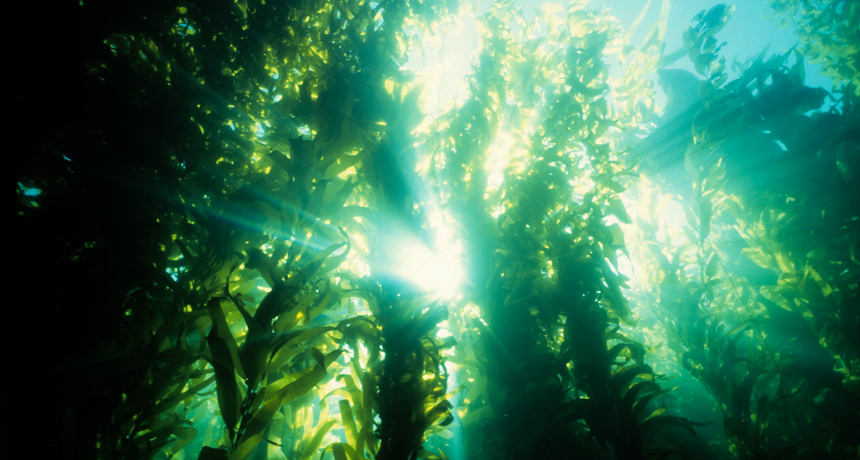
This type of algae is kelp, and kelp forests are sometimes called the rainforests of the seas.
Tammy616/Getty Images Plus
Algae: You know it when you see it. It’s the slimy green carpet that blankets the top of ponds or neglected swimming pools. It may be long strands of seaweed, sometimes used for fertilizer or food, that sway with the ocean tide. Or, algae may show up as the poisonous red tides that bloom near the coast and threaten marine life.
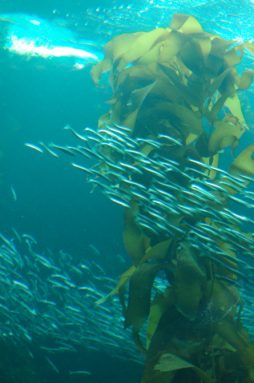 |
|
This kelp forest is in Monterey Bay off the coast of California.
|
| Tania Larson, U.S. Geological Survey |
Algae may be easy to see, but appearances can be deceiving. There’s an ongoing problem with algae that has pestered scientists ever since they started trying to organize and classify the natural world. Different types of algae may look similar, but they’re actually very different organisms.
Algae may range in color from red to brown to yellow to green. Some types are tiny and visible only under a microscope. One good example: the plant-like phytoplankton. Others types, like giant sea kelp, can grow to more than 100 feet long. Some types of algae are unicellular. That means the entire organism is made of one cell. Others are made from many cells.
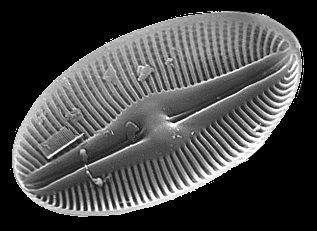 |
|
Diatoms are one of the single-celled types of algae. Pictured is a scanning electron micrograph image of Diploneis puella.
|
| USGS Geology and Environmental Change Science Center website |
Strangest of all, there are types of algae that sometimes behave like plants — and sometimes behave like animals. Like a plant, these algae use photosynthesis to make food. (During photosynthesis, plants or algae use light from the sun to turn carbon dioxide and water into oxygen and food.) But when sunlight is not available, these organisms can still survive by eating other organisms — including other algae! (What would you call that? Cannibalgae?) That behavior is more like an animal because animals can’t synthesize their own food.
Algae are notoriously difficult to classify. So much so, say some scientists, that maybe the best idea is to stop using the word “algae” altogether — except that it’s been around so long it’s too late to change.
Your cousin Chlamy
In 2007, an international team of biologists looked at all the genes of a simple green alga called Chlamydomonas reinhardtii, or Chlamy for short. Genes carry the instructions of life “written” on tightly coiled molecules called DNA inside every cell. Chlamy’s genetic “instruction book” has about 15,000 genes, which is about 8,000 fewer genes than in humans. When the biologists compared Chlamy’s genes to other organisms, some interesting trends emerged.
A large number of Chlamy’s genes can also be found in flowering plants. But it might be surprising to know that roughly 35 percent of Chlamy’s genes can be found in both flowering plants and humans, the research team reported earlier this year. Plus, about 10 percent of Chlamy’s genes can be found in human cells but not plant cells.
No one is going to invite Chlamy to the family reunion, of course. And Chlamy isn’t that unusual — many different living things have identical genes. But Chlamy is interesting: It shows how evolution can deliver some surprising tricks, like producing algae that is genetically similar to humans and plants.
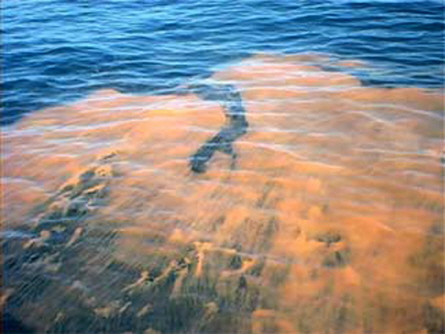 |
|
A red tide is a poisonous bloom of algae that can kill marine life.
|
| NOAA |
Scientists have always had trouble classifying algae. In ancient Greece, the philosopher Aristotle — probably the first scientist to try to organize all living things — simply placed algae in with plants. (Plants and animals were “beneath” humans, and humans were “beneath” angels.)
In the 18th century, a Swedish botanist named Carl Linnaeus suggested a system that grouped all plants together and grouped all animals together. Like Aristotle, Linnaeus called algae a plant. Linnaeus’ system also showed how similar animals — such as dogs and wolves, for example — could be grouped together. The system is still in use today, though it has been modified and changed significantly in the past 250 years. But even with hundreds of years of changes, algae stick out like a sore thumb.
“The study of algae has changed a lot, but it has always been a problem,” says Rick McCourt. He’s a biologist at the Academy of Natural Sciences in Philadelphia, Penn. McCourt is also a phycologist (Fy-KOL-uh-gist), or a scientist who studies algae. (Phycology is the study of algae.)
McCourt points out that the algae problem goes back much farther than Linnaeus or even Aristotle. Much farther: The roots of algae’s identity crisis go all the way back to the beginning of life on Earth, billions of years ago.
Bacteria move in
About 3 billion years ago, Earth was a different planet. It was not populated by people, animals or plants, and the atmosphere was mostly carbon dioxide. Earth’s inhabitants were microorganisms such as bacteria, so small they’re impossible to see without the help of a microscope.
So how did that Earth become the planet on which we live? Many scientists who study evolution blame one particular organism called cyanobacteria. (Sometimes known as blue-green algae or blue-green bacteria, these microorganisms were grouped together with algae until just a few years ago.)
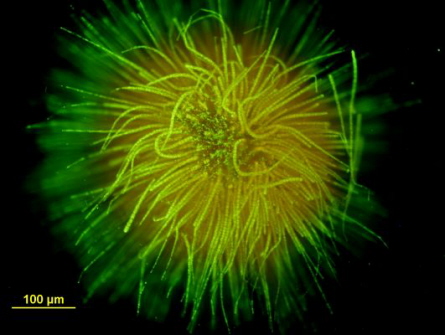 |
|
When cyanobacteria, or blue-green bacteria (pictured is the cyanobacteria Gloeotrichia stained with sytox green), invaded another organism, algae was the eventual result.
|
| Barry H. Rosen, USGS |
“Blue-green bacteria changed the world more than any other group of organisms,” says Brent Mishler. He’s a phycologist at the University of California, Berkeley. Blue-green bacteria were capable of photosynthesis, he says. That means they started taking carbon dioxide and adding oxygen to the atmosphere.
Scientists think that blue-green bacteria are also responsible for algae. Here’s how: These bacteria may have been the first organisms to stay alive through photosynthesis. That means they used sunlight, water and carbon to make their own food.
Other organisms regularly fed on the blue-green bacteria as well. One of these organisms was the ancient ancestor of green algae. But this ancient alga wasn’t green back then — it was colorless.
And one time, when this algal ancestor ate one of these blue-green bacteria, something strange happened. The organism didn’t digest the bacteria — it absorbed it.
Instead of becoming dinner, that bacteria became a permanent resident inside the other organism. Biologists believe that bacteria-inside-an-organism is the oldest ancestor of all green algae. These two organisms each had their own set of genes, but after millions of years and many, many, many generations, the genes mixed and both sets became essential for the alga’s survival. The two organisms had become a single organism.
“It’s the only explanation that makes sense,” says McCourt. “Everything we call green algae descended from a single ancestor, maybe from a single cell, long ago in the ocean or in the freshwater.”
Green algae isn’t the only type of algae. Other types — including brown algae, red algae and diatoms — also evolved in a similar way. “What makes all the algae groups algae is that some of the cyanobacteria went and lived inside them,” Mishler says. “But they were invaded separately.”
Different types of algae may not be related in ancient, ancient history, but every type of algae evolved from an organism that, once upon a time, was invaded by blue-green bacteria. These invaded organisms were not necessarily similar. Green algae and brown algae, for example, are often grouped together because they both use photosynthesis to make food, and because they’re both found in the water. But they have very different family histories. Green algae evolved after one type of organism was invaded by cyanobacteria, and brown algae evolved after a different organism was invaded.
This distinction explains why there are so many different kinds of algae — and why the algae family is still hard to pin down. Scientists have shown that many different types of algae are related only distantly, despite the fact that they may look similar.
And some of these scientists say algae’s classification problem isn’t with algae at all, but with the system we use to organize living things. These scientists advocate for a new system — one based on evolutionary ancestors, rather than on the current appearance and structure of an organism.
Changing classification systems
The original invasion that gave us algae happened billions of years ago, but since then, algae’s evolutionary story has been filled with similar invasions. Even today, it’s easy to see how algae too have invaded other species.
Mishler points out that algae are responsible for the brightly colored plumes that can be observed on giant clams or the vibrant appearance of coral. Algae also live inside octopi. “There’s a parallel story over and over again, with algae invading a host,” says Mishler. “They like to live in other organisms.”
Earlier this year, scientists found an invasion in the making: A sea slug that regularly feasts on algae was found to have absorbed algal genes — the ones used to do photosynthesis.
But just because the invader is the same for all these host organisms doesn’t mean the host organisms are related; it just means they’ve been invaded. And if the evolutionary development of algae is considered, then maybe “algae” shouldn’t be its own group of organisms.
Some biologists, like Mishler, say it’s time to change the system that we use to organize the living world. A better way, they say, would be to organize living things according to how they evolved.
The problem in classifying algae is just one example of the issues that scientists who care about naming things grapple with. And their work is just starting. Dozens of new plant and animal species are found every year, and each one of those new species has to be studied, classified and named.
The system for classifying organisms also gives those organisms their names. It’s important that scientists agree on the same names. “Unless you can name something you really can’t talk about it,” says McCourt. “Giving a species a name is necessary in order to study and understand what it’s doing.”
“If a young scientist wanted to get a good career and go outside and do adventurous things, this would be an exciting career,” says Mishler. “It’s one of the older careers in biology, but it’s still not finished.”
And there will always be new species to find: “There are probably more organisms out there we don’t know than those we do know,” Mishler says.







